Every healthy democracy should strive to have the greatest turnout among eligible voting adults. In the United States, the turnout has historically been low and often under 50% of eligible voters during midterm elections. The Republican party has also survived off of lower turnout rates as those who are not voting or not able to access a polling place are those who would vote for the Democrats or for other parties. An examination of voter turnout trends per State in the United States of America would reveal a lot of interesting conclusions about the health of democracies in the States of America.
In this piece some key elements of State voting will be examined. One of those is the legislative control of the state as the U.S. census is mandated by Article I, Section 2 of the United States Constitution, which states: "Representatives and direct Taxes shall be apportioned among the several States... according to their respective Numbers.... The actual Enumeration shall be made within three years after the first meeting of the Congress of the United States, and within every subsequent Term of ten Years”. The Constitution leaves the redistricting to the states, only stating: "The Number of Representatives shall not exceed one for every thirty Thousand, but each State shall have at Least one Representative." The number of representatives in the House used to grow with the population but has been capped at 435 since the reapportionment in 1960. Now, states do not add representatives when their population increases but instead compete with other states for a portion of the 435. This makes the Census, redistricting and reapportionment a critical focus of partisan activities and determines the political makeup of the United States for at least the next 10 years. States are empowered by the constitution to draw their districts, which can make their legislatures have outsized power in the makeup of their states. These legislatures have the power and obligation to draw legislative districts every ten years and control the processes through which individuals in the state may vote and what obstacles may be placed in people’s way.



Partisan Trends
There are some overall trends which can be pulled out of the overall data and be attributed to all states in the United States. One of those drivers for turnout is a prominent and engaging presidential race between one or two candidates who draw a lot of attention. This is seen in the 2008 election of Obama and the 2020 defeat of Trump to Biden. This turnout extends into other races happening during that same election, whether it be Gubernatorial, State legislature, Congressional or other. This is seen also in more prominent and attention getting non-presidential elections in some states, especially in Senatorial elections.
Alabama
In 2008 and 2010 the state legislature was controlled by the Democrats, but following that it was lost to the Republican party who have maintained control ever since.
Alabama ranks near the middle when looking only at turnout compared to other states. Taking the last 12 years of general elections, an average of 52% of people in the state of Alabama voted in those elections. This puts Alabama at 35th out of 50 states.

2014 was an uninspiring year following the defeat of the Romney/Ryan ticket and all but undeniable re-election of Senator Jeff Sessions. 2018 is a completely different story, following the record turnouts in response to the Trump presidency, there was even enough push to elect Democrat Doug Jones for a term in the Senate. The state of Alabama does not automatically register its voters but it does allow them to register online, as long as it is before the day of the election. The state requires a photo ID to vote, does not allow early voting, and limits absentee mail-in voting to those who are disabled or physically absent from their polling place on election day. The legislature of the state will be redrawing their districts following the 2020 Census with the governor having the opportunity to veto the district maps.
Alaska
Alaska is a continually interesting state, leaning R but often electing independent governors and having split legislatures. With an average of 60% of eligible Alaskans voting in the last 12 general elections, Alaska is doing well and coming in at 11th out of 50 states for voting turnout. Alaska only encompasses one district, so besides having a larger Senatorial influence per citizen compared to other states, they are not subject to redrawing districts every ten years.

2010 is very interesting in Alaskan politics. Current Senator Lisa Murkowski had been ousted in a primary challenge but regained her seat with a write in campaign. Lower turnout in a non-presidential election may have helped her with the success of that write in campaign. With highs in 2008 and 2020, it is obvious that notable presidential candidates can significantly drive-up turnout. 2014 was an interesting year with a single house race coming down to a 10% difference between the Republican and Democrat candidates with the Rep candidate winning. The state of Alaska automatically registers its voters and allows them to register online and on the same day of the presidential election, but if done on the same day they are limited to just the presidential office. The state does require a non-photo ID to vote, but allows early and absentee mail-in voting without requiring a specific reason. Alaska encompasses only one Congressional district so they do not re-draw any districts following the 2020 Census.
Arizona
Arizona has been working its way from red to purple over the past few election cycles, successfully delivering for President Biden in the 2020 elections. Arizona’s turnout is not great, sitting near the bottom of the rankings at 41 with an overall average of 50% of citizens voting in the past 6 elections.
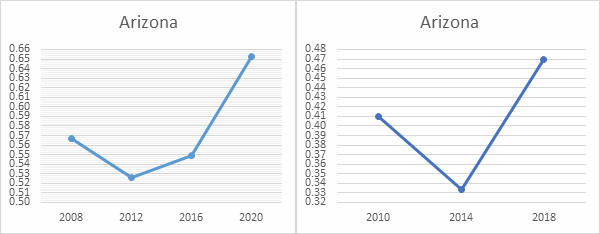
Like many states, 2018 was a referendum on the Trump presidency, with a high turnout bringing Democrat Kyrsten Sinema into a senate seat formerly held by Republican Martha McSally who had been appointed to fill the rest of the late senator John McCains seat. Senator Sinema was elected on a Democrat and Progressive platform but has been a significant disappointment if not outright sabotaging the Democrat agenda and handing the country back to the Republican party. The state of Arizona does not automatically register its voters but does allow online registration, being allowed to vote if they have registered before the day of the election. The state requires a photo ID or two forms on non-photo identification, but the state also allows early voting and absentee mail-in voting without needing an excuse. The state has a non-politician commission who will be redrawing their districts following the 2020 Census.
Arkansas
Arkansas, once voting Dem in the late 00’s is now firmly in the Republican parties’ hands. Turnout is near the bottom of the states at only a 47% average turnout which comes in at 45th out of 50 states. Turnout in 2014 is different from many other states, possibly driven by the Senatorial race in the state which led to a victory for Republican Tom Cotton.

The state of Arkansas does not automatically register its voters and does not allow online or same day registration. The state requires a photo ID to vote in elections and limits its absentee voting to those who are disabled or physically unable to reach their polling place on the election day. The state does allow early voting. Arkansas is the only state with a redistricting commission composed of the Governor, Attorney General and Secretary of state as opposed to the legislature or an independent commission. This means that while the districts are not set by those who are elected within those districts but are still redrawn by those wishing to maintain their status quo and parties’ power.
California
California is the population heavyweight and one of the strongholds of the Democrat party. Turnout is certainly middling in a state with so many people, with an average of 52% of people voting, with a rank of 36 out of 50 states.
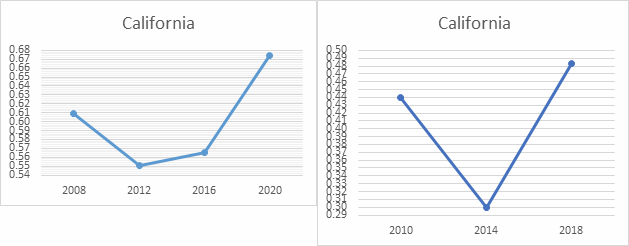
The state will come out in strength for democratic presidential candidates as is evident in 2008 and 2020, but in midterms and years where the democratic candidate is not the incumbent the turnout is comparably terrible. The state of California automatically registers its voters and allows online and same day voter registration. The state also allows early and universal mail in absentee voting without requiring a specific reason. California’s independent commission will be redrawing their districts following the 2020 census.
Colorado
Colorado is a standout in voter turnout, with every election in the last 12 years over 50% turnout. On average the states turnout is 64% with a ranking of 4th!

There has been a notable increase which can be seen on the graphs as the years have progressed, increasing voter turnout. One reason for this may be the fact that Colorado has what is considered one of the best in mail-in and absentee voting systems in the state. Mail in voting is considered the norm and all voters are sent ballots weeks before the elections. One can also register to vote during the entire election day and then cast your ballot. Essentially, Colorado makes voting simple and easily accessible while also providing ample time for anyone to find time to do such. The state of Colorado automatically registers its voters, allows them to register online and on the same day of the election. The state requires a non-photo ID to vote, and also allows early and absentee voting as the primary method, adopting a primarily mail only election system. Colorado’s independent commission will be redrawing their districts following the 2020 census.
Connecticut
Connecticut doesn’t allow early voting and limits the mail and absentee availability. Connecticut ranks pretty high at number 15 with a turnout percentage of 58%. That average is pulled down by lower average turnout on non-presidential years.

Connecticut is solidly Dem state but has elected some split legislatures in the past. Democratic safety may explain the low turnout in 2012 and 2014, coupled with the senatorial elections only happening in 2012 and 2016. The state of Connecticut automatically registers its voters and also allows online and same day registration. The state requires a non-photo ID to vote and limits absentee voting to those who are disabled or physically absent from their polling place on the election day. The state does not permit early voting. The legislature will be redrawing their district maps following the 2020 census.
Delaware
Delaware, one of the original colonies, is strongly Dem and sits just above the middle of the state rankings at 22 out of 50. The average turnout for the last 12 years was 55% of eligible voters.

Delaware encompasses only one district, so they don’t get to do any redistricting. Voting in Delaware is generally on election day, with some exception for absentee voting. Voters are not automatically registered but can register online. 2014, a year with overall low turnout across the USA was also low for Delaware, with the Senatorial election re-electing the incumbent Dem senator Chris Coons not doing much to increase turnout. Delaware does not automatically register its voters but does allow online registration, requiring voters to do so before the day of the election. The state requires a non-photo ID to vote, limits its absentee voting to those who are physically absent from their polling districts or suffer from a disability. The state does not permit early voting. The state of Delaware encompasses only one congressional district and as such will not be redrawing any districts following the 2020 Census.
Florida
Florida is a strong Republican state and a bastion for the Republican party. Turnout is pretty good, especially for a higher population state at 58% of eligible voters participating on average, at number 16 out of 50 states.

2010 was not an exciting election year in Florida and that is marked by low turnout. Republican Marco Rubio wins with an easy margin as Senator from Florida and Rick Scott squeaks by to become the Republican Governor. Florida does not automatically register its voters and does not allow same day registration, but the state has implemented an online voter registration system. The state requires a photo ID with a signature to vote, but does allow early voting and no excuse absentee mail-in voting. The Republican State legislature is redrawing the district lines following the 2020 census, subject to the Governors veto.
Georgia
Georgia, a bastion of the old south, surprisingly delivered for the Democrats in the 2020 presidential election. Georgia certainly would have ranked lower before 2020, but its average comes up to 54% of eligible voters participating with a rank of 28 out of 50.
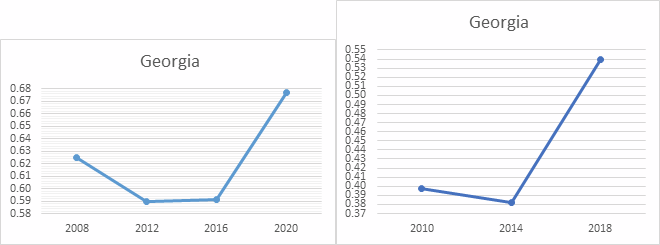
In 2018 the Democratic Party mounted a serious gubernatorial challenge against the Republican Party candidate Brian Kemp with Stacy Abrams. She lost after a close race plagued with issues but paved the way for a successful Democratic Presidential delivery in 2020. Organization and turnout in Georgia was key for Democrat victory in the state. Georgia illustrates that strong organization with turnout can combat underhandedness, but all of it takes significant investment and solid individuals in their positions. The state of Georgia automatically registers its voters and allows them to register online as well, but does not allow same day registration. The state requires a Photo ID to vote but allows no excuse absentee mail-in voting and early voting. The states legislature will be redrawing their districts following the 2020 Census.
Hawaii
Hawaii is a disappointment in turnout terms. They come in at 50 out of 50 with a total average turnout of eligible voters of only 44%.
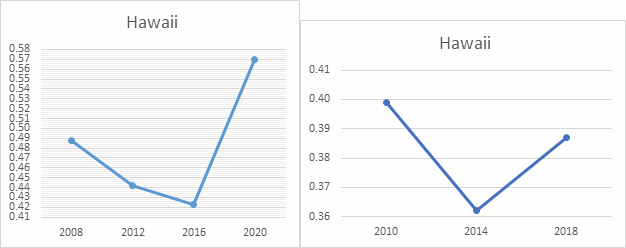
Hawaii is certainly strongly democratic, though they did elect republican governors in 2008 and 2010. There are many factors that could be responsible for the dismal turnout in the state, one being the ‘certainty’ of democratic victory for the state and federal elections. It is certain that there are local issues that influence how people within the state participate and decide when they are involved in voting. 2014 and 2016 many of the candidates were incumbents (not including the presidential election) and incumbent elections generally do not attract as much turnout. One can register to vote online and vote early or by mail in the state. The state is strongly Dem state, but takes last place with low turnout. The state does not automatically register its voters but does allow them to register online and on the same day as the election. Following the 2020 census, an independent commission will be redrawing Hawaii’s districts. Hawaii permits early voting and conducts its elections primarily through mail with all eligible voters automatically receiving mail ballots. An independent commission will be redrawing the states districts following the 2020 Census.
Idaho
Idaho comes in at number 29 out of 50 states with an average of 54% of eligible voters participating in an election in the last 12 years. The state has been strongly Republican over the last 12 years. The state mirrors many other states and federal trends. As a strong republican state, turnout may be low as candidates from that party are generally assured to be elected.

As with other states there is a spike in 2018 and 2020 as referendums on the Trump presidency. 2016 was a re-election year for incumbent Senator Mike Crapo and with a comfortable margin over opponents, he won handily, without a real challenge to drive any significant turnout. The state allows online registration but does not automatically register its voters. The state requires a Photo ID to vote but also allows no excuse absentee vote by mail and early voting. Idaho’s non-political commission will be redrawing their district maps following the 2020 census.
Illinois
Right near the middle of the rankings at 26 out of 50 states, Illinois citizens have turned out to vote on average about 55% over the last 12 years. Illinois is generally a Democratic party state, anchored by the huge city of Chicago providing a strong Dem backbone to the state. This has rankled state republicans, with ideas of secession from Chicago and creating another state being bandied about every few years.

In both 2016 and 2018, the state had a Republican governor while the legislature was held by the Democrats. Illinois is also the home state of President Obama, and his word often has extra impact on the activities of the state. The state came out in 2016 compared to other states to support Hillary Clinton, who was also born in the state. The state automatically registers its voters and allows them to do so online as well. Illinois allows early and mail voting, and as of 2021, voters can be registered with a permanent mail voting list, skipping the need to request an absentee ballot each year. Illinois’ legislature will be redrawing their district maps following the 2020 Census, subject to a veto from the Governor.
Indiana
Indiana, Mike Pence’s home state, is near the bottom of the state rankings for voter turnout. At number 43 out of 50 states, over the last 12 years of elections, an average of 49 percent of people have turned out to vote. Indiana is generally a Republican state but has in the past elected split legislatures, putting the state closer to the middle than some others.

The 2018 turnout was a wave of R support for state and federal candidates, including the first term election of Senator Mike Braun. Indiana does not automatically register its voters but does allow them to register online. The state requires a Photo ID to vote, allows early voting, but limits absentee voting to those with disabilities and physically absent from their polling place on election day. The state legislature is redrawing their districts maps following the 2020 census and will be subject to an executive veto.
Iowa
Iowa is another stand out in terms of turnout. Iowa comes in at number 5 out of 50 states with an average turnout over the last 12 years of 63%. Iowa has moved into the Republican camp in the recent years, but transitioned from Dem to split to Republican control. 2008 and 2012 the state went for President Obama and the Democratic party in the presidential elections. In 2008 the state was Dem and in 2012 it was split between the parties. With the change in state control so did the change in presidential party choice, with the state going Republican in the 2016 and 2020 elections.
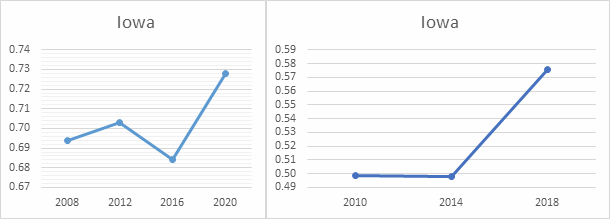
The state does not automatically register its voters but does allow them to do so online and the same day as the election. The state requires an ID to vote. Iowa does allow mail voting without requiring a reason as well as early voting, which may contribute to the high-quality turnout the state sees in its elections. Following the 2020 census the state legislature, assisted by an advisory commission will be redrawing their districts, subject to an executive veto.
Kansas
Welcome back, Dorothy. A generally republican state which recently elected a Dem governor, Kansas’ turnout is nothing to write home about. Coming in at 30 out of 50 with an average turnout of 54% over the last 12 years, Kansas is in the bottom half of state turnout rankings.
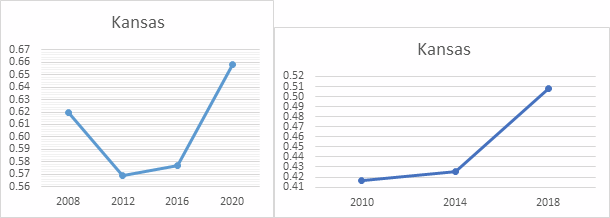
High turnout in 2018 and 2020 generally supported republican candidates, but the success of a Dem Governor could be attributed to that higher turnout or the low appeal of the Republican opponent Kris Kobach. In Kansas, one may register to vote online and may vote by mail as absentee called ‘advance voting’ without any special reason. The state does not automatically register its voters and requires a Photo ID to vote. Kansas’ legislature will be redrawing their districts following the 2020 census with the final maps subject to an executive veto.
Kentucky
Kentucky comes in at a disappointing but not surprising 34 out of 50 states with an average turnout of 53%. Many people think of Kentucky as a strongly Rep state, but that actually is not the case. The state has often elected split legislatures, and not counting 2018, there was at least either a split legislature or a democrat governor. A turnout rise in 2014 may be attributable to a race that was somewhat close between long time senator and incumbent Republican Mitch McConnell against Democrat Alison Lundergan Grimes.

The state came out strong for the Republicans in both 2018 and 2020 as compared to other years where the party threat was lower. Voters in Kentucky can register to vote online but that must be done before the day of the election. Kentucky allows early voting but limits absentee or mail voting to those who are not in their voting precinct during the election. Kentucky’s legislature will be redrawing their district maps following the 2020 census, with those maps subject to an executive veto.
Louisiana
Louisiana sits in the bottom half of the rankings at number 33 out of 50. An average of 53% of eligible Louisianans voted in the last 12 years of elections. Louisiana’s partisan history over the last 12 years is a bit of a tradeoff between the two parties, with the republicans maintaining strong control between 2012 and 2016, but the Democrats had held the legislature before that and have captured the Governor’s office in 2018 and 2020. Higher turnout in 2014, 2018 and 2020 may be a contributor to this party change within the state, especially with the contentious elections in 2018 and 2020.
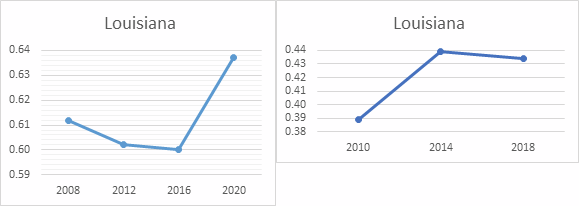
In 2014, a longstanding Democrat senate seat was lost to the Republicans for the first time in 132 years, with high turnout benefitting republicans as well. In Louisiana one must register to vote in person or by mail 30 days before an election. The state does allow early voting but limits absentee voting to those who are not within their precincts on election day. Following the 2020 census, the state’s legislature will be redrawing their districts, subject to an executive veto. This district fight may be interesting to watch with a Republican Legislature and a Democrat executive.
Maine
Maine is a very interesting and unique state. Holding Dem from 2008 through 2010, the state flirted with split control and Republican majorities until reclamation by the Dems in 2020. The state enacted ranked choice voting as a ballot measure following the 2016 elections. Maine comes in at number 3 out of 50 states with an average turnout of 65%. The state delivered three delegates for Biden in 2020 and one for Trump, as Maine is one of the few state which splits its delegates between the statewide popular vote and the congressional districts.

The state voted similarly in the 2016 election between Trump and Clinton as well. Low turnout in 2010 can be attributed to the two incumbent candidates for the House of Representatives winning re-election and there being little in the way of competitive races and divisive candidates. In Maine, one can register to vote on the same day as election day, does not require any identification to vote and also allows mail in absentee voting and early voting. The state has recently enacted an automatic voter registration law which is set to come into effect in 2022. The state legislature and an advisory committee will be redrawing their districts following the 2020 census, whose maps will be subject to veto by the executive branch of the state.
Maryland
Maryland was a democratic stronghold from 2008 to 2014, but following that the state has become much more split between parties. While the legislature has remained Dem, the state has elected a Rep governor in the last three Gubernatorial elections. Maryland comes in the top 15 at number 13 out of 50 states for average eligible turnout at 59%. Maryland was not interested in coming out en-masse, in any of the elections from 2008 to 2016.

The state has reliably gone for Democratic Presidential candidates in the last eight presidential elections, so the motivation for high turnout was not great until there was the opportunity for a referendum on the Trump presidency in 2018 and then denying re-election in 2020. In Maryland one is automatically registered to vote, but can also register online, by mail or in person and can register on the day of the election. There are no ID requirements in the state and it allows voters to vote early and absentee by mail without reason. The states legislature will be redrawing their districts following the 2020 census, subject to an executive veto. This will be another cross party district battle which may become interesting to watch.
Massachusetts
Just inside the top ten, Massachusetts comes in at 9 out of 50 states in terms of turnout over the last 12 years. On average, eligible voters turned out 60% of the time in the state. The state used to be strongly Dem, but has elected a Republican governor the past three opportunities.

More turnout in the 2016, 2018 and 2020 elections may have contributed to the change in party control of some state offices. The state stayed democratic for the previous presidential elections and generally strongly votes for democratic presidential candidates. In Massachusetts one is automatically registered to vote though many different state agencies, and an individual can also register online, but must be registered before election day. The state does not require an ID but limits absentee voting to those not within their precincts. The state does also allow early voting. The states legislature will be redrawing their districts following the 2020 census and those maps will be subject to executive veto. Another party split to watch the district drawing fight with interest.
Michigan
Michigan comes in at 12 out of 50 states for average turnout, with a 59% average turnout over the last 12 years for eligible voters. Michigan had a period of strong Rep control from 2012 to 2018, but the democrats regained the governorship in 2018 following mismanagement and criminality from many republican executive branch members relating to the Flint Water Crisis.

Michigan’s turnout mirrors many other Midwest states which lean center-left. Excitement in 2008 for the Obama presidency dropped after his first term and turnout did not rise for the Trump presidency in 2016, which was narrowly delivered to the republican candidate that year. The voters came out en masse in 2018 and 2020 to decisively refute republican candidates and the presidency of Donald Trump. Michigan automatically registered people to vote through the Department of Motor Vehicles but also allows residents to register to vote online. In the state, voters may also register and vote on the same day, through mail, absentee or early. Through a ballot measure in 2018, the state established an independent commission to draw the representative districts of the state following the 2020 census.
Minnesota
Our reigning campion has arrived. Minnesota ranks number 1 out of 50 states in terms of voting turnout over the last 12 years and their eligible voters participated on average 68% of the time. Minnesota leans democrat but often elects a split legislature and has elected a republican governor occasionally in the past. As a state which consistently delivers for Democrat presidential candidates, the drop in turnout in 2016 can certainly be attributed to the political climate at the time.

2014 was an overall re-election for incumbent democrat candidates across the state and an overall low performer for turnout. The state’s average was greatly increased in 2018 and especially 2020 where they reached almost 80% turnout. The state makes it easy and accessible for its citizens to vote, which is also a contributor to this great turnout. One can register online and on the same day as the election to vote and does not require IDs. Anyone in the state can vote absent or by mail without a reason and can also vote early. Minnesota’s state legislature will be redrawing their district maps following the 2020 census, and those maps will be subject to the governor’s veto.
Mississippi
Mississippi comes in the bottom ten of the state rankings at number 43 out of 50 states in terms of turnout over the past 12 years. The states eligible voters turned out 49% of the time. Mississippi is a pretty strongly red state but did elect a Dem legislature in 2008 and 2010. Mississippi’s flag was one of the last to still have the confederate battle flag featured on it, with it being redesigned in 2021. The state has consistently delivered for Republican presidential candidates.

Many other states saw higher turnout in 2020 compared to 2008 or any other recent years, but Mississippi did not. The states strong republican control and lack of motivating democratic candidates, but higher turnout generally favors Dems overall. Mississippi does not automatically register voters and also does not allow online registration. Voters must be registered before the day of the election and must present photo identification to vote. The state does not permit early voting and limits absentee voting to those who are not in their precinct or are physically unable to vote. The states legislature will be redrawing their legislative districts following the 2020 census with the final maps being subject to the governor’s veto.
Missouri
Currently a republican state which has in the past elected split legislatures and Democrat Governors, Missouri comes in near the middle at number 23 out of 50 states. Over the last 12 years in Missouri, an average of 55% of eligible voters participated. Missouri’s average is pulled down by less than stellar turnout in 2012 and 2016 and quite terrible turnout in 2014. 2014 was a minor election year for Missouri with only a House of Representatives election where no districts were flipped.

Without tight races or motivating presidential candidates, few people were interested enough in 2014. The state did not come out as much in 2020 for President Trump in 2020 as they did in 2008 for John McCain, even though Trump did carry the state in both 2016 and 2020. In Missouri citizens are not automatically registered to vote and cannot register on the day of the election, but they are able to register to vote online. The state does require identification to vote and only allows absentee voting for those who are actually absent or unable to vote on the election day, as the state also does not permit early voting.
Montana
Montana encompasses only one congressional district, so as much as their politicians may want, they do not draw any districts every ten years. The state leans republican but often has a split legislature and sometimes a democrat governor. The state comes in at 10 out of 50 states in terms of turnout over the past 12 years with an average of eligible voters at 60%.
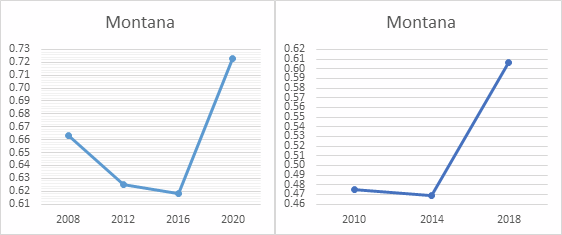
The only elections happening in 2010 was for the singular member of the House and a single Senator in 2014, not driving turnout very much. The state has been reliable for republican candidates and came out strong in 2018 and 2020. Montana makes it easy to vote with early and absentee mail-in voting without needing an excuse. One must register in person or by mail to vote in the state and voters must be registered before election day. The state does require identification to vote in its elections.
Nebraska
Nebraska comes in at 27 out of 50 states in terms of average voter turnout, near the middle of the pack. Over the last 12 years, 55% of eligible Nebraskans participated in elections in the state. Politically, Nebraska is somewhat interesting. The state has a unicameral legislature that is also officially non-partisan.

The state has elected a Republican governor every gubernatorial election and the state reliably goes to the republican presidential candidate every four years. For non-presidential election years, the state turnout is low as 2010 for examples there was only a House of Representative and Gubernatorial election. Nebraska does not automatically register its voters, but it does allow them to register online as long as it is before the day of the election. The state does not require identification to vote and allows its citizens to vote by mail and vote early.
Nevada
Nevada ranks at 39 out of 50 states in terms of average eligible voter turnout over the last 12 years. 50% of Nevada’s eligible voters turned out on average over the last 12 years. Nevada leans democrat but often elects split legislatures or Republican governors. The state delivers for Democrat presidential candidates consistently over the years.

Low turnouts and non-exciting democratic candidates explain Republican pickups in the state after 2012 and 2014. 2014 was also an across-the-board incumbent re-election victory for democratic candidates so without new or exciting candidates the turnout remains low. The state recently enacted automatic voter registration in 2018, but it has yet to be implemented. It will be interesting to see what kind of increase will arise from that. One can already register to vote online and on the same day as the election. The state allows mail in voting and early voting for all registered voters.
New Hampshire
Another top ten state, New Hampshire comes in at number 7 out of 50, with a turnout over the last 12 years among eligible voters of 62%. The state was historically conservative but in recent years has gone back and forth between Democrats and Republicans. The last years the state has leaned back to the right, bringing state control back to the Republicans. On a national level, the state has supported Democrat presidential candidates.

Low 2010 turnout may have given the Republicans the chance to pick up the two House seats as well as a Senate seat. In the state of New Hampshire voters must register in person or by mail only, but they can register on the same day of the election. The state requires a photo ID to be allowed to vote. The state does not permit early voting and limits absentee voting to those who are physically absent or prevented by a disability. The state legislature will be re-drawing the legislative districts following the 2020 census, whose maps will be subject to the Governor’s veto.
New Jersey
Right in the middle of the pack, New Jersey comes in at number 25 out of 50 states for their average turnout of eligible voters over the last 12 years. Of these eligible voters, 55% of those have turned out over the last seven election cycles. The state is generally Democrat but has elected Republican governors in the past years. The state has stuck with Democrat Presidential candidates the last eight elections as well. Heavily influenced by the neighboring strongly Democratic New York City and State of New York, Republican Governorship was lost by former longtime governor Chris Christie.
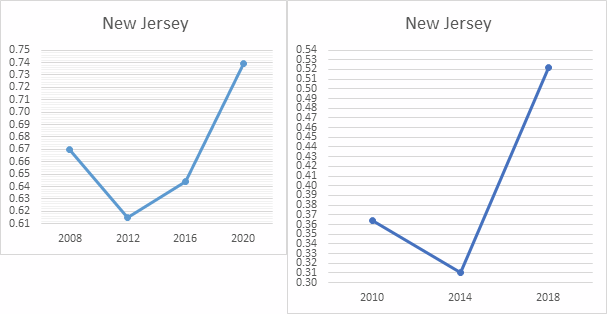
2014 like many states was an uninspiring year of candidates with incumbent Democrat Senator Cory Booker winning re-election along with no seat changes for the Representatives in the House. As of 2018, New Jersey automatically registers its voters, which they can also do online, as long as it is before election day. New Jersey does not require identification to vote and also allows voters to vote absentee by mail or vote early without a reason. Redistricting in New Jersey, following the 2020 census will be redrawing their districts through a political commission. Leaders in the state legislature and leaders from the main parties of the state appoint various members to a committee. If the committee cannot come to an agreement, the states Supreme Court will appoint a tie breaker.
New Mexico
The state of New Mexico comes at 37 out of 50 states for their voter turnout. Over the past 12 years the turnout for eligible voters has been an average of 51%. The state, generally democrat, has voted for split legislatures and some Republican governors. The last Republican presidential candidate the state supported was George W. Bush in 2004.

The state was not very active in the re-election of President Obama or for the election of President Trump, with party status quos being maintained in those House and Senate elections. The Democrat and Republican breakdown of the state has remained similar over the years. The state automatically registers its voters, which they can also do online. In 2021, same day voter registration is expected to go in to effect in the state. The state does not require ID to vote and allows residents to vote absentee by mail or vote early for any reason (or none at all). Following the 2020 census, the state legislature will be redrawing the legislative districts along with the help of an advisory committee. The Governor will have the option to veto these maps once they are finished.
New York
The state of New York ranks at 44 out of 50 states for average turnout of eligible voters over the last 12 years, which is 49% of those voters. The state is a Democrat bastion mainly due to the influence from the cities of New York and Buffalo. The state has elected split legislatures every once in a while, but the state is generally strong for the Dems.

Dipping in 2012 with the less exciting re-election of President Obama, the 2014 turnout was quite low, the senate races being Democratic incumbents running and winning re-elections, whereas the low turnout may have helped the Republicans gain three seats in the House of Representatives from the Dems. The states turnout perked up in 2016, no doubt it being the home state of then presidential candidate Donald Trump. The 2018 mid term turnout almost reached the presidential turnout levels as a reaction and repudiation of President Trump. The state allows voters to register online and have just implemented an automatic registration system. The state does not allow same day registration but does not require IDs to vote. The state allows early voting but limits mail-in absentee voting to those who have are out of their precincts or physically unable to reach their polling place due to a disability. The state uses an interesting hybrid system to redraw their district maps following the 2020 census. A non-politician commission drafts maps, and the legislature can reject two sets of maps before it can add its own amendments.
North Carolina
North Carolina comes in at number 20 out of 50 states in the rankings. The eligible voters of the state turned out on average 56% of the time over the past 12 years. The state has shifted from the Dems to the Republicans in recent years, though it has elected democrat governors the last two years. Though the state delivered for Trump in both 2016 and 2020, the outcome was much closer in 2020. The state did go for President Obama in 2008 but went Rep in 2012. The increased turnout in 2020 was not enough to bring the state back to the Dems.

The high turnout in 2018 was also not enough to flip the Republican Senate seat back to Democrats, but it made the race a close one. The state does not automatically register its voters, but they can register online and can register to vote the same day as voting during the early voting period before election day. The state does require a photo ID to vote but a court order found that law to be in violation of the state’s constitution and it is not enforced. The state does allow absentee mail-in voting without requiring a reason. Following the 2020 census the legislature will be redrawing their districts, which they have the final say over.
North Dakota
North Dakota comes in at number 19 out of 50 states in terms of average voter turnout over the past 12 years. In that time, 56% of eligible voters have turned out. North Dakota is strongly R and consistently elects a republican legislature and governor. Turnout 2010 and 2014 was low, with incumbent democrat senators not seeking re-election and Republican senators taking the seat with sizeable margins.
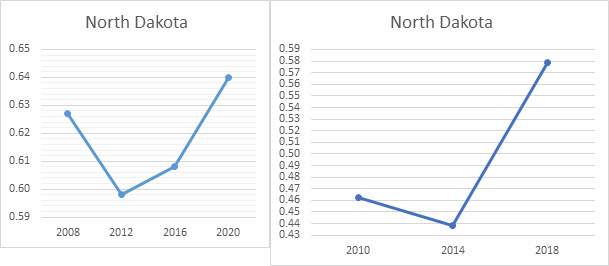
The state has gone for Republican presidential candidates each election, but interestingly, Bernie Sanders, longtime independent Democratic-Socialist Senator and multiple presidential candidate has routinely won the Democrat Presidential primary in the state. North Dakota is the only state which does not require its residents to register to vote, instead requiring identification to be provided by voters at polling places. The state also allows early voting and absentee mail-in voting without needing a reason. North Dakota encompasses only one congressional district so the legislature will not be redrawing any districts following the 2020 census.
Ohio
Ohio comes in at 21 out of 50, just able the middle. Over the last 12 years, 56% of eligible voters on average turned out to vote in the state. In 2008 and 2010 the state did elect a split legislature and a democrat governor, but ever since the state has been in the hands on the Republican party. Turnout in 2012 was higher than 2016, reflecting the more moderate political stance of the state, delivering for Obama in 2012 and Trump in 2016. 2012 and 2018 were also years where the democrat state senator, the only democrat from the state in federal office to win re-election over republicans in both those years.

Turnout in 2014 is low due to the only race being a House of Representatives race where both parties maintained their seats. The state of Ohio does not automatically register its voters but does allow them to register themselves online, by mail or in person, as long as it is before election day. The state does require a form of identification to vote, but allows its voters to vote absentee by mail without needing a reason and also allows early voting. The state’s legislature will be redrawing their legislative districts following the 2020 census, with the Governor having the opportunity to veto those maps.
Oklahoma
Oklahoma ranks near the bottom at 47 out of 50 states in terms of average eligible voter turnout. Over the last 12 years, 46% of eligible voters in the state have turned out to vote in elections. Electing a democrat governor in 2008 and 2012, the state has been firmly republican since. Oklahoma turned out for Republican presidents in the last four Presidential elections, with low turnout in 2012 being attributed to the expected win of Democrat incumbent President Barack Obama depressing Republican voter turnout.
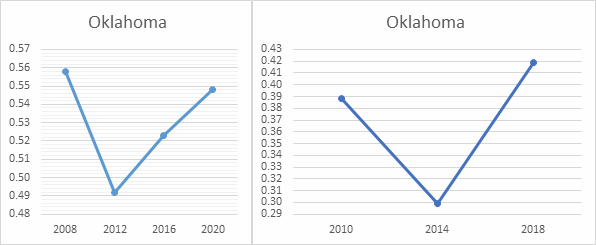
All but guaranteed victories for Republican Senate and House incumbent candidates in 2014 kept turnout low as well. Oklahoma does not automatically register its voters, but it has partially implemented an online voter registration system, but it does not currently allow new voters to register. Oklahoma does not allow voters to register on election days, and does require a photo ID for residents to vote. The state does allow mail-in absentee voting without requiring a reason and also allows for early voting.
Oregon
Almost in the top five, Oregon comes in at 6 out of 50 in terms of eligible voter turnout over the past 12 years. Of those eligible voters, an average of 62% have turned out. Oregon is a strongly Democrat state, mostly due to the concentration of population in the capital of Portland pushing the state to the left. 2010 and 2014 were secure re-elections for House and Senate candidates from the state, and the strong margins by which they won means that many individuals don’t find the need to turn out.

The state was not excited about the re-election of President Obama as evident by the low turnout, something which was repeated in 2016 as many of the citizens preferred not to vote over voting for non-exciting Democrat candidates. 2018 and 2020, the states large liberal population came out in droves to refute the Trump presidency. In Oregon, the state automatically registers voters and also allows them to register online, as long as they do that before election day. The state is a vote-by-mail state, where it conducts its elections though mail as much as possible. The state was the first to enact a vote-by-mail election system in 2000. A drivers license or state ID number is required to vote in the state, either provided on the mail-in ballot or in person at a clerk’s office on election day. The Oregonian legislature will be redrawing their districts following the 2020 census with the possibility of a Gubernatorial veto.
Pennsylvania
The state of Pennsylvania comes in at 24 out of 50 states in our rankings. Of the eligible voters in the state over the past 12 years, 55% of those turned out. The state leans center right, commonly electing Republicans to state offices, but recently elected a Democrat governor in 2016. The state supported Obama in both 2008 and 2012, with low unexcited turnout in 2012. Solid Republican turnout in 2016 brought Republican victory for Trump, but the state returned to Democrats in 2020 with great turnout and a competitive race.

Low 2014 turnout can be attributed to the only race being the House of Representatives with no seats being swapped between parties. In Pennsylvania, the state does not automatically register its voters, but it does allow them to register online. Only voters participating for their first time are required to provide some form of ID when voting. The state permits early and absentee mail-in voting without requiring a reason. Pennsylvania’s state legislature will be redrawing their districts following the 2020 census, subject to the Governors veto.
Rhode Island
The state of Rhode Island reaches rank 31 out of 50 for state turnout over the past 12 years. On average for the eligible voter, 54% of them turned out. The state is pretty solidly Democrat, but did elect Republican governors in 2008 and 2010 and an independent one in 2012. The state has voted for Democrat presidential candidates every year since 1984, but the low turnout in 2016 made the race closer than usual in the state.
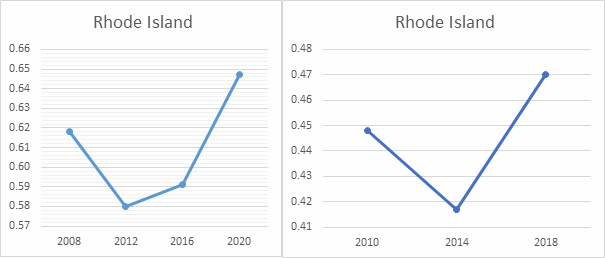
The state recently enacted automatic voter registration and also allows voters to register online. Rhode Island limits same day registration to presidential elections, and required a Photo ID to vote at the polls. Rhode Island permits early voting but limits absentee voting to those who are outside of their polling place on election day or physically unable to vote due to a disability. The states legislature, assisted by an advisory committee, will be redrawing their legislative districts following the 2020 census. The Governor will have the opportunity to veto the maps if they do not agree with them.
South Carolina
South Carolina comes in at 38 out of 50 states in terms of average voter turnout. Over the last 12 years, eligible voters have turned out on average 51% of the time in the state. Strongly Republican, the state is a reliably conservative bastion of the south. This conservative majority and reliability explains the low turnout in 2008 and 2012, years where a democrat presidential candidate generally dominated.

The low turnout in 2016 is interesting but Trumps margin of victory that year was higher than in 2020 even though the state went for Trump both years and turnout was much higher in 2020. 2014, like in many other states, was an uninteresting election year for voters, with Republicans in the House of Representatives maintaining their seats and the Rep Senate candidates winning handily as they were both incumbents. The state of South Carolina has implemented an online voter registration system, but does not allow voters to register on election day if they wish to vote that day. The state requires a photo ID to vote and limits its absentee voting to those not present in their polling district on election day or those who are unable to reach their polling places due to a disability. The state also does not permit early voting. The states legislature will be redrawing their district maps following the 2020 census, with the possibility of a veto from the Governor.
South Dakota
South Dakota can be found at number 18 out of 50 states in terms of voter turnout over the last 12 years. Within the state, an average of 57% of voters turned out over the past 7 elections. The state of South Dakota is a reliably Republican state which also enjoys greater Senatorial influence per citizen due to their small population size. The 2014 Senate election with low turnout, the incumbent Democrat senator not seeking re-election, and an independent candidate splitting the left vote, the Republicans were able to capture the open seat and secure both Senate seats for the Republicans.
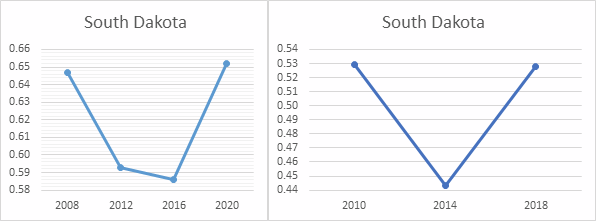
2010 was a great year for John Thune, incumbent Republican senator, as he ran unopposed and secured 100% of the vote. The 2008 election saw solid turnout and the race was somewhat close, but delivered for candidate John McCain, as the state reliably does for Republican candidates. 2012 and 2016 were both years with candidates and races that did not draw high turnout across the US and that is mirrored here in South Dakota. In 2018, the House Republican candidate won handily, and in 2020 the state delivered to Trump with a strong margin. The state of South Dakota does not practice automatic voter registration, does not allow online registration, and also required voters to be registered to vote before election day. The state also requires a photo ID to vote, but does permit early voting and mail-in no-excuse absentee voting. Because the state encompasses only one Congressional legislative district, the state will not be doing any redrawing of maps following the 2020 census.
Tennessee
Tennessee ranks near the bottom of states at number 46 out of 50 states. Over the past 12 years, the average turnout of eligible voters has been 47%. The state is controlled reliably by the Republican party, but the state has elected Democrat governors in 2008 and 2010. While turnout was much higher in 2020 compared to 2016, but Republican candidate Trump won the state with a similar 60% majority. 2014 saw House and Senate elections in the state, but the low turnout had no difference on the Republican party maintaining their seats with a majority of voters.

Tennessee does not automatically register its voters, but they can register online as long as it is before the day of the election in which they wish to vote in. The state does require a photo ID, and limits absentee voting to those who are outside of their polling place on election day or somehow physically unable to reach their polling place. The absentee law also makes exceptions for those over the age of 60. The state does also permit early voting. The state’s legislature will be redrawing their legislative maps following the 2020 census. The governor will have the opportunity to veto the maps when they are complete.
Texas
Texas ranks close to the bottom at 48 out of 60 states, with an average turnout of eligible voters over the last 12 years at 46%. The state is historically strongly Republican, but has made hints of turning purple the last few elections, mostly due to the urban areas and increased immigration from other states. The state has delivered for Republican candidates in the past four presidential elections, though the margins of victory have dropped between 2008-2012 and 2016-2020. Low turnout in 2014 allowed the Republican Senator John Cornyn to win re-election and the Republicans to pick up a House seat from the Democrats.

2018 was a notable year with Democrat candidate Beto O’Rourke narrowly losing to Republican Senator Ted Cruz. That year and the increased turnout and Democrat response to the Trump presidency also allowed Texas Dems to pick-up two House seats. Texas is the state to watch in the next few elections. Texas does not automatically register its voters, does not allow online registration or same day registration. The state requires citizens to present a photo ID when voting, and does allow early voting. Absentee voting is limited to those out of their polling place on election day, physically unable to make it to their polling place, or are over the age of 65. The state legislature will be redrawing their legislative districts following the 2020 census. The governor will have the opportunity to veto the maps once they are completed.
Utah
Utah ranks at 40 out of 50 states in terms of average voter turnout over the past 12 years. Of those eligible voters during that time, 50% of those individuals turned out to participate. Utah is a strongly Republican state, but that is undercut by the independent nature of Utah and the strong Mormon makeup of the state and culture. Republican presidential candidates generally secure a strong majority in the state, with a 70%+ majority coming in 2012 when Utah native Mitt Romney ran against President Obama for the presidency.
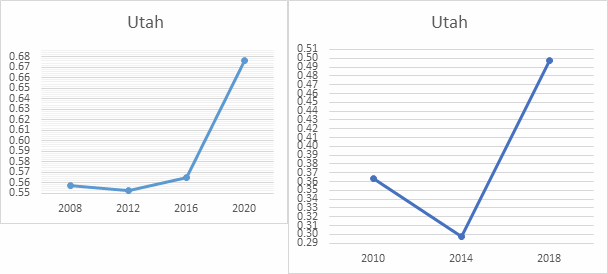
With only a House election in 2014, the Democrats lost a seat, possibly due to the low turnout of the year. High turnout in 2018, coupled with the repudiation of Republican Donald Trump returned a seat to the Dems. The state does not automatically register its voters, but they can register online and register on the same day as election day. The state does require an ID to vote and permits early voting and no-excuse mail-in absentee voting. The state conducts the majority of its elections through mail. The Utah legislature, along with an advisory committee, will be redrawing their legislative districts following the 2020 census. The governor of the state will have the opportunity to veto them when they are complete.
Vermont
The state of Vermont ranks at 14 out of 50 in terms of voter turnout. The eligible voter turnout out on average 58% of the time over the past 12 years. The state leans Dem but has elected Republican governors in 2008, 2010, 2018 and 2020. Low turnout and strong Dem control in 2014 all but guaranteed the success of the Democrat candidate in the 2014 house race.

The state generally goes for Democrat presidential candidates above 60%, but with the lackluster candidates in 2016, the margin of victory for candidate Clinton was only around 55%. The state automatically registers its citizens to vote in the state through the DMV, and also allows its citizens to register online up to the same day as the election. The state requires ID only for first time voters. The state permits early voting and allows voters to vote absentee by mail without needing a reason. Because the state of Vermont encompasses only one legislative district, its legislature will not be redrawing any districts following the 2020 census.
Virginia
The state of Virginia ranks at 17 out of 50 states in terms of voter turnout. Over the past 12 years, 57% of eligible voters have participated in elections. The state leans Dem but often elects republican governors or has a split legislature. The state has gone Democrat in the last 4 Presidential elections, but the margins are often pretty close. 2008’s turnout was higher than 2012 or 2016 as voters were more excited for President Obama in his first term.
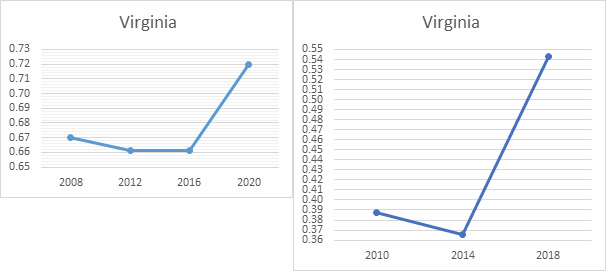
The rise in turnout in 2018 was good for the Democrats of Virginia, seeing them re-elect Senator Tim Kaine and seeing them pick up 3 House seats off of the Republicans. The state strongly repudiated the Republican party in 2020 with greatly increased turnout. As of 2020, the state now automatically registers voters through the DMV as well as allowing them to register online but not on the same day as the election. Also in 2020, the state changed its Photo ID requirement to remove the photo part of that, as well as establishing mail-in absentee voting without requiring a reason. The state allows early voting as well. Following the 2020 census, the state of Virginia has set up a commission evenly divided between politicians and non-politicians to draw new legislative maps. Those maps then go to the full legislature, who has the opportunity to veto them twice before ending up at the Supreme Court to decide.
Washington
The state of Washington comes in at number 8 out of 50 states in rankings. Over the last 12 years, of average eligible voters, 60% of those turned out to vote in the state. Washington is a strongly Dem state with the metropolis capital of Seattle anchoring the Democrat power. Higher turnout in 2010 brought a competitive House seat into Republican hands, with low 2014 turnout resulting from only a House election with no change in seat control.
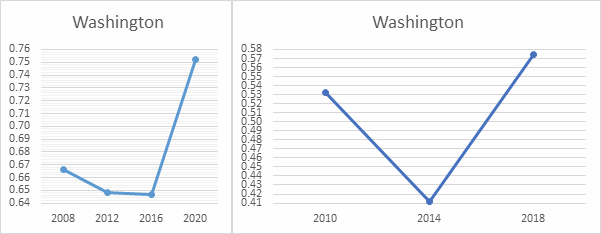
The Dems recovered that House seat in 2018 with high turnout, and turnout skyrocketed in 2020 as a response to the Presidency of Donald Trump. The state of Washington automatically registers its voters through many different government organizations, allows online voter registration and same day registration on election day. Voting in person requires a Photo ID, but since the state’s elections are conducted through mail, this is not much of a limiting factor. The state of Washington was the second to enact a vote-by-mail majority legislation, following the state of Oregon in 2000. Following the 2020 census, a non-politician commission is meeting to redraw legislative districts in the state.
West Virginia
West Virginia ranks at 49 out of 50 states in terms of eligible voter turnout. On average over the past 12 years, an average of 45% of voters in the state have turned out. West Virginia is a strongly Republican state, delivering for Republican Presidential candidates over the past 4 Presidential elections. Joe Manchin, a very moderate center right Democrat Senator from the State was consistently won re-election with a small majority as he did in 2010. The other senator from the state, Shelley Moore Capito, a Republican, usually wins with a large majority.

Outside of Manchin, Republicans have had a strong hold on state and federal offices. The state of West Virginia automatically registers its voters through the DMV and also allows its citizens to register online, requiring them to be registered before election day if they wish to vote. The state requires an ID to vote, but limits is mail-in absentee voting to those who are outside their polling place on election day or are physically unable to vote, and the state also allows early voting. Following the 2020 census, the state’s legislature will be redrawing their districts, with the governor having the possibility to veto the maps when they are completed.
Wisconsin
The state of Wisconsin ranks number 2 in the ranking of states in terms of average voter turnout. Over the past 12 years, 66% of eligible voters have turned out to vote. Wisconsin is generally Democrat state but has been controlled by the Republican party the past 5 election years. The state came out strongly for Democrat candidate for President Obama in both 2008 and 2012. Very low turnout in 2016 quite possibly explains the ability of Republican candidate Trump to take the state in 2016 but not in 2020 with very strong turnout. Turnout was higher than others in 2012 also due to the recall election of Rep Governor Scott Walker, who survived the measure with a larger majority than his first election. This same year also held recall elections for four state senators as well.
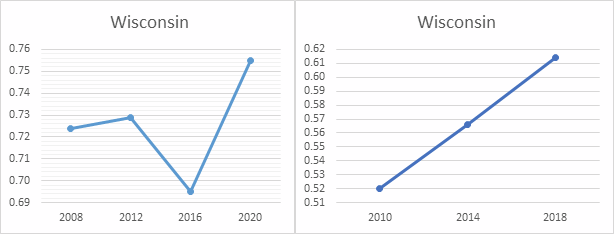
The state also had high turnout in 2014 compared to other states as that was another Gubernatorial election year with contentious Republican Governor Scott Walkers’ re-election. Wisconsin does not automatically register its voters but does allow them to register online and on the same day as the election. The state requires a Photo ID, but also allows its voters to vote absentee by-mail without a reason and also permits early voting. Following the 2020 census, the states legislature will be redrawing their districts, with the Governor having the option of vetoing them.
Wyoming
The state of Wyoming comes in at 32 out of 50 states in terms of voter turnout over the past 12 years. On average, 54% of eligible voters turned out. Wyoming is a strongly Republican state mostly due to its small population and rural nature, and also enjoys outsized Senatorial influence compared to the size of its population. Over the past four presidential elections, no Republican candidate has won the state with less than a 64% majority. Non-competitive opposition candidates and a strongly one-sided party registration in the state means that most election years result in handy majorities for Republican state and federal elections. In 2014, the Republican House and Senate candidates won by over 68%.
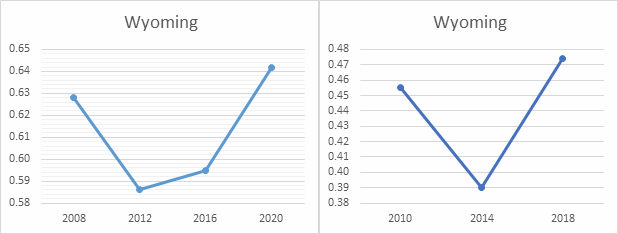
Regardless of year or turnout amount, the state continually elects Republicans with significant majorities. The state of Wyoming does not automatically register its voters and also does not allow them to register online, but it does permit its voters to register the same day as the election. The state requires an ID to vote but also allows universal mail0in absentee voting without requiring a reason, and permits voters to vote early. Following the 2020 census, the legislature of the state will be redrawing their districts, with the Governor having the opportunity to veto them.
Information for this article can be found on the individual states government websites and comprehensive information on election systems can be found on https://ballotpedia.org
To view my spreadsheet of information used to compile this article click here: https://docs.google.com/spreadsheets/d/1XEfh7Krbg9V3pQf95Oqq0SrEdu2lAmbcakKpkC4WX7w/edit?usp=sharing
Comentarios